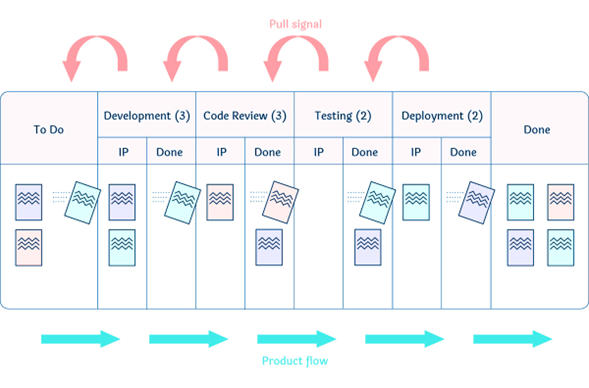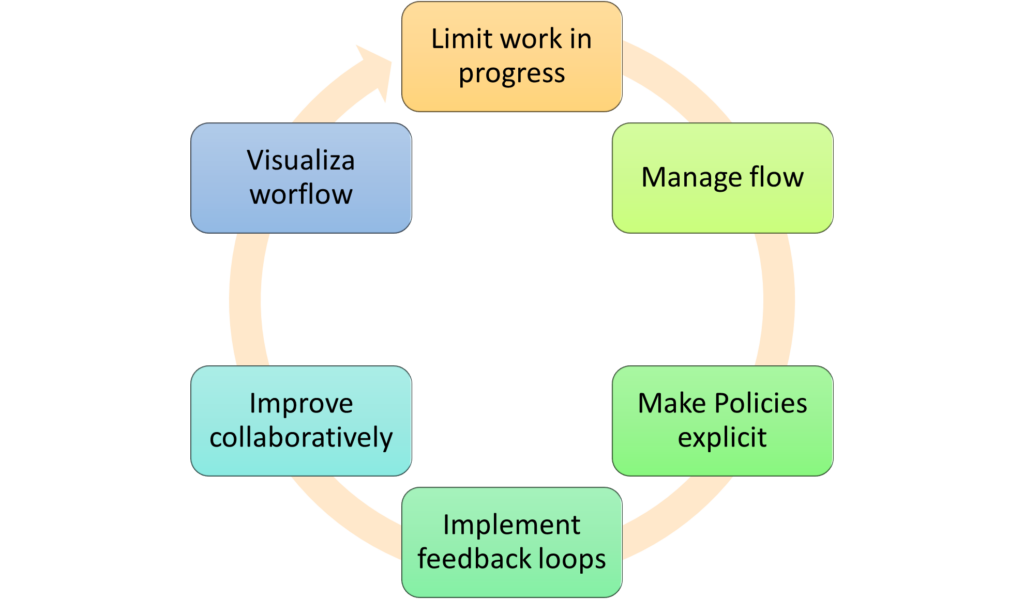
Save Project Time With the Kanban Method
Have you ever heard about the Kanban method? It is a method of work management that emerged in the Toyota Production System in the late 40s. At that time Toyota began to work with the “just in time” production system, so production was based on demand. This system started the foundations of Lean Manufacturing and lean production. What does this mean? That it is a production whose objective is to minimize waste, that is, create more value for customers but without generating more expenses.
What is Kanban?

Figure 1. The Kanban Method. Source: https://getnave.com/blog/what-is-the-kanban-method/. Author: Sonya Siderova
Currently using Kanban boards are excellent tools to organize the workflow. In addition, it is a very flexible method, which allows you to modify processes in the face of interruptions or unexpected and increase productivity. How? Through its 3 Kanban board states: To do, done and ready.
At the beginning of the day, or the beginning of a project, a list of objectives is drawn up, these are works that have to be carried out. The tasks that are on this list will be moved to the next as they are carried out, so they will first be in “to be done“, then “in progress” and, finally, in “done“. This is how the habit of computing tasks at work is worked, transparency is better since all team members know the state in which the project is and what each team member is dedicating their time to.
Thus, the Kanban method follows the philosophy “Stop Starting, start finishing“, this means that it focuses on prioritizing the work that is already started before starting any other. In this way, there are a maximum number of tasks that can be performed for each phase before starting with the next one.
Advertisement
[widget id=”custom_html-68″]
How does Kanban work?
There are several basic principles to get the most out of your workflow.
- Visualize what you do (your workflow): A visualization of all your tasks and items in a table will help all members of your team to stay on top of your work.
- Limit the amount of Work in Process (WIP): Set affordable goals. Maintain the balance of your workflow by limiting in-process jobs to prevent over-commitment in the number of tasks you will be unable to complete.
- Track time: Time tracking converges with the Kanban methodology. Track your time continuously and evaluate your work accurately.
- Easy reading of visual indicators: Know what’s happening at a glance. Use colored cards to distinguish Job Types, Priorities, Labels, Deadlines, and more.
- Identify bottlenecks and eliminate what’s disposable: make the most of lead times and cycles, Cumulative Flow, and time reporting. These criteria will allow you to evaluate your performance, detect problems, and adjust the workflow accordingly.
Even the most basic Kanban method will produce an increase in performance. A simple distribution of tasks, coupled with monitoring your workflow and making appropriate adjustments throughout the process will increase your efficiency. A software development team can experience formidable improvements over 12 months, following the implementation of Kanban. Delivery time can be reduced by 37% and consistency in delivery can be rebounded by 47%.

Figure 2. Kanban Practices
Saving time with the Kanban method
Time is the central part of the Kanban philosophy, which is why most teams that bet on this method opt for time tracking. One of the great advantages of Kanban is the ability to point out bottlenecks in development processes by imposing a limit on the number of active tasks a team can have open at any given time. if the number of tasks in the process is too high the team must identify the problem and resolve it.
However, it is important to understand that bottlenecks do not have to be a symptom of an organizational problem, nor do they mean that developers are too slow. Rather, they indicate that an attempt has been made to cover more work than the team could manage, so it is time to either look for more staff or reduce the workload and extend the time of the project.
But what are the other advantages of the Kanban method?
With the Kanban method is very easy to detect bottlenecks, but this work system has many more benefits.
- Prevention of unnecessary processes: through Kanban boards an effective transmission of information is carried out so that failures and delays caused by poor communication can be avoided. This translates into agile development and avoiding unnecessary additional processes.
- Encourages teamwork: all the workers of the team have access to information, know the process and know what tasks have to be performed previously so that theirs can be performed, even those who may be waiting for their task to be finished to be able to start theirs. In this way, solidarity between the team is strengthened and the active participation of all staff is encouraged.
- Production flexibility: this method allows you to respond quickly to changes and make the necessary adjustments to the strategy. In addition, as we have said before, only what is necessary is produced or carried out, so resources and time are saved.
- Increase in the efficiency of the processes: it is clear that those processes that generate greater profits in the best conditions, with the highest quality, and in the least amount of time are the most effective for the company. Kanban allows performing the necessary tasks for the phases of the project within the necessary period.
That is why the Kanban method is ideal for companies that require a lot of flexibility, especially in terms of entry of new tasks, as well as during the monitoring of these. Using the Kanban boards you can perform supervision of the work team and the tasks in progress, as well as get a global vision.